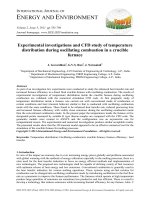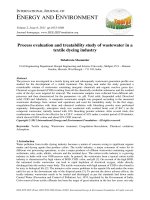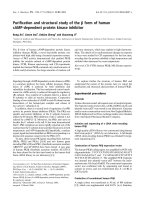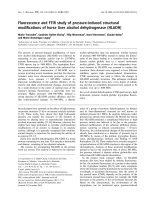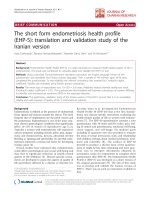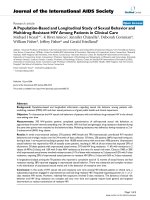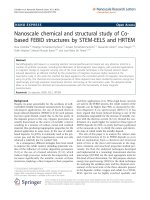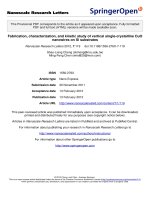Standardization and storage study of Aonla (Emblica officinalis Gaertn) based blended ready-to-serve beverages
Bạn đang xem bản rút gọn của tài liệu. Xem và tải ngay bản đầy đủ của tài liệu tại đây (274.24 KB, 10 trang )
Int.J.Curr.Microbiol.App.Sci (2017) 6(5): 1275-1284
International Journal of Current Microbiology and Applied Sciences
ISSN: 2319-7706 Volume 6 Number 5 (2017) pp. 1275-1284
Journal homepage:
Original Research Article
/>
Standardization and Storage Study of Aonla (Emblica officinalis Gaertn)
based Blended Ready-To-Serve Beverages
Naval Singh Devra, R.A. Kaushik and H.R. Meena*
1
Department of Horticulture, Rajasthan College of Agriculture, MPUAT,
Udaipur- 313001(Rajasthan), India
2
ICAR- Indian Institute of Soil and Water Conservation, Research Centre,
Kota- 324002 (Rajasthan), India
*Corresponding author
ABSTRACT
Keywords
RTS, Aonla,
Lime, Blendedbeverage, Storage.
Article Info
Accepted:
12 April 2017
Available Online:
10 May 2017
The present study was conducted with comprised six levels of recipe, three blending ratio,
9 treatments with ginger juice (2%) and 9 treatment without ginger juice {aonla: lime
(25:75, 50:50 and 75:25), aonla: orange (25:75, 50:50and 75:25), aonla: pomegranate
(25:75, 50:50 and 75:25)with ginger juice aonla: lime: ginger (25:73:2,50:48:2
and75:23:2), aonla: orange: ginger (25:73:2, 50:48:2 and 75:23:2), aonla: pomegranate:
ginger (25:73:2, 50:48:2 and 75:23:2) and one control (100% aonla juice)+ acidity
(0.3%)+TSS (10%)}, thus total 19 treatment combination were laid out under CRD statics
design with three replication. Among various treatments tried in this investigation, the
aonla based blended RTS beverage T 16 treatment aonla: pomegranate: ginger (25:73:2) and
T17 aonla: pomegranate: ginger (50:48:2) were statistically at par with each other and
found best on the basis of organoleptic quality (taste, flavour and overall acceptance) after
120th days of storage. The TSS, total sugars, reducing sugars and non-enzymatic browning
showed increasing trend while, the acidity, ascorbic acid, pH and phenols showed
decreasing trend under ambient condition. However, maximum retention of ascorbic acid
was recorded in T17 (44.50mg/100ml) treatment and minimum acidity in T 18 (0.34%)
followed by T17 (0.39%) treatment. The relative economics of treatment T 17 gave the
highest net return (Rs 36.95/lit) RTS as compared to other treatments.
Introduction
The aonla (Emblica officinalis Gaertn) fruits
are richest source of vitamin C being 200 to
1814mg/100g (Ram, 1990). But it has very
little table value due to acrid and bitter taste.
The fruits are utilized generally after
processing into various products therefore,
this, investigation was under taken to
standardize the appropriate ratio of Aonla
with lime, orange and pomegranate with and
without ginger juice for preparing Aonla
based blended RTS. Aonla fruit is sour and
astringent in taste; hence it is not popular as
table fruit and goes as a waste due to limited
usage. The excellent nutritive and therapeutic
value of fruits has great potentiality for
processing into various quality products viz.
preserve, sauce, candy, dried chips, tablets,
jellies,
pickles,
toffees,
powder,
chayvanprash, etc. These products can get
position in national and international markets.
1275
Int.J.Curr.Microbiol.App.Sci (2017) 6(5): 1275-1284
Aonla fruit juice can also be blended with
other fruit juices like lime, orange,
pomegranate, ginger, etc. to improve
nutritional quality, taste and consumer
acceptance of RTS and make use of high
vitamin C available in Aonla fruits,
processing of Aonla fruits is necessary for
sustainable crop cultivation and alleviating
malnutrition among rural population in
addition to several health benefits. Blended
RTS of Aonla with lime, orange, pomegranate
and ginger for the production of new products
is necessary for the survival and growth of the
processing industry, to meet new taste and
demand in home as well as in export market.
Hence, there is an urgent need to develop
some suitable technologies for the preparation
of Aonla beverages which are economical and
easily available to a large population. In India,
soft drinks have a good demand throughout
the year. Traditionally, our country has been
well known for offering syrup or sharbat. If
synthetic drinks can be substituted with the
fruit juice, it would be beneficial to the
consumers as well as fruit growers. Looking
to the demand of natural beverages, there are
great scopes for the preparation of juices and
other fruit based beverages.
Ready-To-Serve (RTS) is a type of fruit
beverage containing at least fruit juice (10%),
total soluble solids (10%) and acidity (0.3%)
(F.P.O.1955).
However,
the
problem
encountered
during
processing
is
development of bitterness, the juices of two or
more fruits are mixed to yield well balance,
rightly flavoured drink, which is rich in
essential minerals and vitamins. Besides, the
blending of two or more juices helps in
utilization of astringent and too acidic fruits
like lime, sour palm, sour cherry, etc. These
fruits and spice are also famous for excellent
quality with pleasant flavour, rich in sugar,
vitamin C, minerals and ginger juice have
antimicrobial and antibiotic properties which
are good for human health. Therefore,
blending of two or more fruit juices for the
preparation of ready-to-serve beverage
appears to be a convenient and economic
alternative for utilization of Aonla. Sandhu
and Sindhu (1992), Saxsena et al., (1996),
Attri et al., (1998) and Langthasa (1999),
have reported that two or more fruit
juices/pulp may be blended in various
proportions for the preparation of nectar, RTS
beverage, etc.
Materials and Methods
The fully mature, Fresh and uniform fruits of
Aonla were taken from the Horticulture farm
of Rajasthan College of Agriculture, MPUAT,
Udaipur (Raj.). There are total 19 treatment
combination were laid out under Completely
randomized design with three replication The
immature, brownish, damaged and off type
fruits were discarded and fruits of lime,
orange, pomegranate and ginger were
purchased from the market and brought to the
Post Harvest Technology Laboratory of the
Department on the same day. Fruits were
inspected thoroughly for any damage and
spoilage. The selected fruits were washed
with tap water thoroughly to remove dirt and
dust particles adhering to the surface of fruit
then again washed with chlorinated water and
allowed to surface dry. Their individual juice
was extracted by coil type juice extractor
machine, filtered through a cleaned muslin
cloth and kept for few hours in refrigerator
(40+20C) for sedimentation then after blended
as per recipe treatments. Stored Aonla based
blended RTS beverages was analysed for
sensory (Rangana, 1978) and chemical
parameters analysed as per slandered methods
of (A.O.A.C, 1995) at 0, 30th, 60th, 90th and
120th day of storage. The total soluble solids
(TSS) measured by the “Zeiss” Hand
Refractometer (0-50) and value obtained was
corrected at 20ºC (A.O.A.C, 1995). The
ascorbic acid was estimated by methods
suggested by (A.O.A.C, 1995), pH by digital
1276
Int.J.Curr.Microbiol.App.Sci (2017) 6(5): 1275-1284
pH meter (Systronics micro pH system-361)
after standardization with a buffer (pH 4.0 at
20°C), non-enzymatic browning by alcohol
extraction method (Klim and Nagy, 1998),
phenols content was determined by Folinciocalteau phenol reagent method suggested
by (Sadasivam and Manickam, 1991), total
sugar content was determined by using
anthrone reagents method (Dabois et al.,
1951) and reducing sugar content was
measured as suggested by Miller (1972) using
dinitrosalicyclic acid.
Results and Discussion
Data pertaining to the effect of recipe and
storage period on physico-chemical changes
of aonla based blended RTS beverage (TSS,
acidity, ascorbic acid, total sugar, reducing
sugars, non- reducing sugars, pH, phenols and
non-enzymatic browning) during storage were
studied at 15 days interval upto 120th days.
guava beverage (Baramanray et al., 1995 and
Pandey, 2004). Murtaza et al., (2004) in straw
berry drink and Verma and Gehlot (2007) in
bael RTS during storage.
Total sugar
A perusal of data given in table 1b indicates
that the total sugar content of aonla based
blended RTS beverage was non-significantly
influenced by recipe and storage period. On
the first day of storage the highest total sugar
was observed in T6 (9.40%) followed by T15
and T18 (9.39%) whereas lowest in T7 (7.01%)
followed by T1 and T4 (8.30%) treatments.
The total sugar content increased gradually
with the increasing period of storage in all the
treatments. On 120th days of storage highest
total sugar was recorded at T15 (12.00%)
followed by T14 (11.88%) treatment.
Whereas, lowest total sugar were recorded in
T7 (10.28%) followed by T8 (10.53%)
treatment.
Total Soluble Solids (TSS)
Reducing sugar
The total soluble solids content of stored
aonla based blended RTS beverage increased
with advancement of storage period upto the
end of experimentation. The treatments found
to be non-significant during entire period of
storage (Table 1a). On the first day of storage
the highest TSS content was observed in T18
(10.20%) treatment, closely followed by T15
and T17 (10.10%). Similarly, on the 120th day
of storage the maximum TSS content was
observed in T15 (13.00%), followed by T14
(12.91%) whereas minimum in T10 (11.60%)
followed by T8 (11.70%).The increase in total
soluble solids content (on an average 10% at
fresh and ) of Aonla based blended RTS
beverages during storage, this might be due to
hydrolysis of polysaccharides (starch), starch
and pectin substances into monosaccharides
(sugars) and concentration of Aonla based
blended RTS beverage due to dehydration.
Similar, results were observed by Godara and
Pareek (1985) in date palm RTS beverage and
On the first of storage the highest reducing
sugars was observed in T12 (7.58%) followed
by T6 (7.52%) whereas lowest in T7 (5.25%)
followed by T8 (6.26%) treatments. The
reducing sugar content increased gradually
with the increasing period of storage. On
120th days of storage highest reducing sugars
were recorded at T6 and T12 (10.00%)
followed by T19 (9.95%) treatment. Whereas,
lowest reducing sugars were recorded in T7
(8.00%) followed by T8 (8.42%) treatment.
However, treatments T2, T3, T5, T6, T12, T14,
T15, T16, T17, T18 and T19 were found
statistically at par with each other (Table 2a).
The total sugar content of Aonla based
blended RTS beverages increased during
storage period. This could be attributed to the
fact that, the hydrolysis of polysaccharides
during storage results an increase in soluble
sugars.
1277
Int.J.Curr.Microbiol.App.Sci (2017) 6(5): 1275-1284
Table.1 Effect of recipe treatments on (A) total soluble solids and (B) total sugar content of Aonla
based blended RTS beverages during storage
S.N.
Treatments
1. Aonla: Lime (25:75)
2. Aonla: Lime (50:50)
3. Aonla: Lime (75:25)
4. Aonla: Orange (25:75)
5. Aonla: Orange (50:50)
6. Aonla: Orange (75:25)
7. Aonla: Pomegranate (25:75)
8. Aonla: Pomegranate (50:50)
9. Aonla: Pomegranate (75:25)
10. Aonla: Lime: Ginger (25:73:2)
11. Aonla: Lime: Ginger (50:48:2)
12. Aonla: Lime: Ginger (75:23:2)
13. Aonla: Orange: Ginger (25:73:2)
14. Aonla: Orange: Ginger (50:48:2)
15. Aonla: Orange: Ginger (75:23:2)
16. Aonla: Pomegranate: Ginger (25:73:2)
17. Aonla: Pomegranate: Ginger (50:48:2)
18. Aonla: Pomegranate: Ginger (75:23:2)
19. Control(100% Aonla juice)
SEm ±
CD (P=0.01)
0
10.00
10.00
10.00
10.00
10.00
10.00
10.00
10.00
10.00
10.00
10.00
10.00
10.00
10.00
10.00
10.00
10.00
10.00
10.00
0.24
NS
(A) Total soluble solids (%)
Storage Period (Days)
30
60
90
10.32
11.00
11.50
10.35
11.15
11.90
10.45
11.16
12.00
10.16
10.83
11.45
10.11
10.80
11.42
10.20
10.90
11.69
10.45
11.00
11.75
10.29
11.00
11.17
10.32
11.02
11.46
10.19
10.45
11.00
10.21
10.85
11.35
10.24
10.90
11.48
10.26
11.05
11.71
10.26
11.03
11.71
10.48
11.17
11.86
10.45
10.89
11.45
10.57
11.09
11.60
10.68
11.28
12.00
10.45
11.20
11.90
0.25
0.27
0.28
NS
NS
NS
1278
120
11.90
12.30
12.40
12.10
12.20
12.50
12.30
11.70
12.10
11.60
12.00
12.10
12.30
12.91
13.00
12.20
12.50
12.90
12.80
0.30
NS
0
0.76
2.09
1.40
1.19
1.25
3.17
1.98
1.00
0.97
1.10
2.01
0.99
1.01
1.26
1.06
1.00
1.29
1.49
1.60
0.037
0.140
(B) Total sugar (%)
Storage Period (Days)
30
60
90
0.40
0.42
0.57
1.91
1.32
1.86
1.22
0.72
0.82
0.99
0.52
0.75
1.05
0.53
0.82
2.89
2.55
2.81
1.62
1.21
1.43
0.82
0.55
0.73
0.72
0.67
0.86
0.81
0.58
0.78
1.80
1.41
0.67
0.75
0.49
0.75
0.85
0.51
0.72
0.96
0.61
0.84
0.86
0.64
0.88
0.82
0.51
0.60
0.96
0.75
0.89
0.99
0.75
0.94
1.03
0.80
0.98
0.030
0.022
0.021
0.114
NS
NS
120
0.75
2.00
1.06
1.13
1.13
2.90
1.50
0.85
0.92
0.99
1.86
0.91
0.81
0.99
0.98
0.80
1.07
1.09
1.22
0.031
NS
Int.J.Curr.Microbiol.App.Sci (2017) 6(5): 1275-1284
Table.2 Effect of recipe treatments on (A) Reducing sugar and (B) Ascorbic acid content of Aonla based blended
RTS beverages during storage
S.
N.
Treatments
1
Aonla: Lime (25:75)
2
Aonla: Lime (50:50)
3
Aonla: Lime (75:25)
4
Aonla: Orange (25:75)
5
Aonla: Orange (50:50)
6
Aonla: Orange (75:25)
7
Aonla: Pomegranate (25:75)
8
Aonla: Pomegranate (50:50)
9
Aonla: Pomegranate (75:25)
10 Aonla: Lime: Ginger (25:73:2)
11 Aonla: Lime: Ginger (50:48:2)
12 Aonla: Lime: Ginger (75:23:2)
13 Aonla: Orange: Ginger (25:73:2)
14 Aonla: Orange: Ginger (50:48:2)
15 Aonla: Orange: Ginger (75:23:2)
16 Aonla: Pomegranate: Ginger (25:73:2)
17 Aonla: Pomegranate: Ginger (50:48:2)
18 Aonla: Pomegranate: Ginger (75:23:2)
19 Control(100% Aonla juice)
SEm+
CD (0.01%)
0
6.72
6.82
6.88
6.54
7.25
7.52
5.25
6.26
6.74
6.63
6.75
7.58
6.80
6.80
7.04
6.57
6.85
7.04
6.82
0.17
NS
(A) Reducing sugar (%)
Storage Period (Days)
30
60
90
7.18
7.81
8.29
7.55
8.23
9.12
7.65
8.60
9.15
6.88
7.44
8.13
7.40
8.03
8.38
7.79
8.43
9.36
5.64
6.48
7.13
6.79
7.42
7.89
7.16
7.91
8.40
7.03
7.44
8.15
7.11
7.72
8.42
8.08
8.49
9.29
7.02
7.71
8.29
7.12
7.82
8.41
7.39
8.21
9.00
6.94
7.75
8.32
7.36
8.24
8.88
7.43
8.29
8.96
7.24
8.00
8.97
0.18
0.20
0.21
NS
NS
0.81
1279
120
8.81
9.55
9.81
8.71
9.21
10.00
8.00
8.42
9.00
8.90
9.02
10.00
9.11
9.38
9.84
9.19
9.80
9.85
9.95
0.23
0.88
(B) Ascorbic acid (mg/100ml)
Storage Period (Days)
0
30
60
90
120
70.00 61.70 52.00 43.80 30.30
75.00 69.30 60.70 52.30 40.10
92.40 88.20 85.00 76.00 65.00
56.00 50.50 42.30 31.90 20.00
65.67 61.28 53.00 45.30 36.37
82.50 78.11 68.70 59.00 47.10
45.40 39.60 32.50 23.50 15.00
57.20 49.00 41.00 32.00 21.01
60.00 52.20 45.30 37.70 25.00
65.00 57.80 47.40 38.00 26.00
73.00 62.90 53.90 42.30 31.00
90.00 81.70 73.60 61.80 50.70
53.40 48.30 41.40 33.60 19.60
63.96 56.03 46.50 37.65 24.83
82.00 73.70 65.50 56.00 43.90
57.70 48.00 41.70 31.80 19.90
64.20 57.80 48.00 36.90 25.10
71.50 91.43 52.00 38.00 27.00
95.00 91.40 87.70 81.60 80.00
1.78
1.56
1.43
1.17
0.88
6.58
5.97
5.49
4.47
3.38
Int.J.Curr.Microbiol.App.Sci (2017) 6(5): 1275-1284
Table.3 Effect of recipe treatments on (A) pH (B) phenol of Aonla based blended RTS beverages during storage
S.N.
Treatments
1.
Aonla: Lime (25:75)
2.
Aonla: Lime (50:50)
3.
Aonla: Lime (75:25)
4.
Aonla: Orange (25:75)
5.
Aonla: Orange (50:50)
6.
Aonla: Orange (75:25)
7.
Aonla: Pomegranate (25:75)
8.
Aonla: Pomegranate (50:50)
9.
Aonla: Pomegranate (75:25)
10. Aonla: Lime: Ginger (25:73:2)
11. Aonla: Lime: Ginger (50:48:2)
12. Aonla: Lime: Ginger (75:23:2)
13. Aonla: Orange: Ginger (25:73:2)
14. Aonla: Orange: Ginger (50:48:2)
15. Aonla: Orange: Ginger (75:23:2)
16. Aonla: Pomegranate: Ginger (25:73:2)
17. Aonla: Pomegranate: Ginger (50:48:2)
18. Aonla: Pomegranate: Ginger (75:23:2)
19. Control(100% Aonla juice)
SEm ±
CD (P=0.01)
0
2.73
2.72
2.84
3.00
2.93
2.96
2.77
2.58
2.66
2.59
2.79
2.93
2.98
2.86
2.85
2.72
2.74
2.78
3.03
0.061
0.324
(A) pH
Storage Period (Days)
30
60
90
2.69
2.58
2.49
2.70
2.62
2.52
2.81
2.73
2.68
2.96
2.92
2.88
2.91
2.90
2.80
2.91
2.87
2.80
2.75
2.71
2.69
2.55
2.53
2.50
2.64
2.59
2.57
2.55
2.47
2.41
2.76
2.71
2.70
2.90
2.84
2.80
2.91
2.87
2.81
2.85
2.78
2.68
2.81
2.78
2.69
2.70
2.64
2.57
2.70
2.63
2.58
2.76
2.74
2.70
2.79
2.70
2.63
0.057
0.063
0.057
NS
NS
NS
1280
120
2.44
2.47
2.54
2.82
2.65
2.68
2.68
2.48
2.55
2.36
2.68
2.78
2.78
2.58
2.61
2.46
2.56
2.68
2.60
0.058
NS
0
0.76
2.09
1.40
1.19
1.25
3.17
1.98
1.00
0.97
1.10
2.01
0.99
1.01
1.26
1.06
1.00
1.29
1.49
1.60
0.037
0.140
(B) Phenol (%)
Storage Period (Days)
30
60
90
0.40
0.42
0.57
1.91
1.32
1.86
1.22
0.72
0.82
0.99
0.52
0.75
1.05
0.53
0.82
2.89
2.55
2.81
1.62
1.21
1.43
0.82
0.55
0.73
0.72
0.67
0.86
0.81
0.58
0.78
1.80
1.41
0.67
0.75
0.49
0.75
0.85
0.51
0.72
0.96
0.61
0.84
0.86
0.64
0.88
0.82
0.51
0.60
0.96
0.75
0.89
0.99
0.75
0.94
1.03
0.80
0.98
0.030
0.022
0.021
0.114
NS
NS
120
0.75
2.00
1.06
1.13
1.13
2.90
1.50
0.85
0.92
0.99
1.86
0.91
0.81
0.99
0.98
0.80
1.07
1.09
1.22
0.031
NS
Int.J.Curr.Microbiol.App.Sci (2017) 6(5): 1275-1284
Table.4 Effect of recipe treatments on (A) non-enzymatic browning (OD) and (B) Overall organoleptic score of Aonla
based blended RTS beverages during storage
S.
N.
1
2
3
4
5
6
7
8
9
10
11
12
13
14
15
16
Treatments
Aonla: Lime (25:75)
Aonla: Lime (50:50)
Aonla: Lime (75:25)
Aonla: Orange (25:75)
Aonla: Orange (50:50)
Aonla: Orange (75:25)
Aonla: Pomegranate (25:75)
Aonla: Pomegranate (50:50)
Aonla: Pomegranate (75:25)
Aonla: Lime: Ginger (25:73:2)
Aonla: Lime: Ginger (50:48:2)
Aonla: Lime: Ginger (75:23:2)
Aonla: Orange: Ginger (25:73:2)
Aonla: Orange: Ginger (50:48:2)
Aonla: Orange: Ginger (75:23:2)
Aonla: Pomegranate: Ginger
(25:73:2)
17 Aonla: Pomegranate: Ginger
(50:48:2)
18 Aonla: Pomegranate: Ginger
(75:23:2)
19 Control(100% Aonla juice)
SEm+
CD (0.01%)
0
0.018
0.023
0.025
0.027
0.032
0.037
0.035
0.041
0.047
0.020
0.024
0.024
0.023
0.035
0.047
(A) Non-enzymatic browning
Storage Period (Days)
30
60
90
0.018
0.041
0.068
0.026
0.080
0.092
0.039
0.093
0.150
0.033
0.058
0.080
0.034
0.083
0.105
0.058
0.092
0.135
0.035
0.067
0.082
0.047
0.086
0.110
0.068
0.093
0.138
0.020
0.057
0.076
0.035
0.066
0.076
0.041
0.069
0.085
0.034
0.061
0.070
0.041
0.067
0.081
0.047
0.082
0.085
120
0.100
0.110
0.180
0.094
0.115
0.152
0.108
0.134
0.144
0.105
0.109
0.118
0.106
0.110
0.120
0.041
0.044
0.076
0.084
0.118
0.045
0.050
0.085
0.106
0.125
0.048
0.057
0.099
0.127
0.134
0.033
0.0008
NS
0.041
0.0012
NS
0.076
0.0018
NS
0.101
0.0022
NS
0.125
0.0027
NS
1281
(B) Overall organoleptic score
Storage Period (Days)
0
30
60
90
120
8.17
7.82
7.23
6.36
5.48
8.15
7.72
7.06
7.71
5.41
8.00
7.46
6.82
6.09
5.29
8.18
7.87
7.31
6.71
5.60
8.09
7.67
7.10
6.36
5.39
8.03
7.50
7.09
6.27
5.31
8.25
7.89
7.33
6.75
5.90
8.19
7.76
7.24
6.66
5.79
8.14
7.68
7.10
6.43
5.72
8.58
8.18
7.62
7.27
6.92
8.45
8.07
7.48
7.04
6.80
8.41
8.05
7.37
6.95
6.60
8.46
8.16
7.91
7.30
6.84
8.36
8.06
7.82
7.16
6.76
8.27
8.00
7.75
7.07
6.70
9.00
8.85
8.70
8.57
8.13
8.88
8.61
8.17
7.97
7.75
8.58
6.66
0.20
NS
8.35
6.29
0.19
NS
8.15
5.75
0.17
NS
7.79
4.97
0.16
NS
7.37
4.05
0.15
NS
Int.J.Curr.Microbiol.App.Sci (2017) 6(5): 1275-1284
Total sugars of beverages were depended on the
total soluble solids as anticipated. There was
considerable rise in reducing sugars and nonreducing sugars. This might be due to inversion
on non-reducing sugars to reducing sugars
caused by acids present in of Aonla based
blended RTS beverages. Increase in total and
reducing sugars during storage is a general
phenomenon as noticed by Ray and Singh
(1979) in bael beverages, Godara and Pareek
(1985) in date palm RTS beverage at room
temperature (25+50C) Verma and Gehlot (2007)
in bael RTS.
Ascorbic acid
The ascorbic acid content of aonla based
blended RTS beverage decreased with
advancement of storage period in all the
treatments. The treatments had significant effect
on ascorbic acid content of aonla based blended
RTS beverage during the entire storage period
(Table 2b). On the first day of storage the
maximum ascorbic acid content was observed
in T19 (95.00mg/100ml) and minimum in T7
(45.40mg/100ml), however treatment T3, T12
and T19 were found statistically at par with each
other. Similarly, on 120th day of storage, the
maximum ascorbic acid content was observed at
T19 (80.00mg/100ml), followed by T3
(65.00mg/100ml) treatment whereas minimum
in T7 (15.00 mg/100ml), followed by T13
(19.60mg/100ml). A gradual and significant
decrease in ascorbic acid content with the
increasing period of storage was observed in all
the treatments. The maximum retention of
ascorbic acid was observed in T17
(44.50mg/100ml) and minimum in T19
(25.00mg/100ml) treatment. The trend observed
same throughout the storage period. Ascorbic
acid content reduced considerably during
storage period might be due to the oxidation or
irreversible conversion of L-ascorbic acid into
dihydro ascorbic acid oxidase (ascorbinase)
because of heat processing and the presence of
air at the head space of glass bottles. Similar,
trend of declining was noticed by Palainswamy
and Muthukrishnan (1974) in lemon juice
during storage varied between 21.76 to 62.06
mg/100ml juice. Ray and Singh (1979) in bael
beverages and by Reddy and Chikkasubbanna
(2008) in lime blended amla squash during
storage period of 90 days.
pH value
The pH content of aonla based blended RTS
beverage decreased with advancement of
storage period in all the treatments. The
treatments have a non-significant effect on pH
content of aonla based blended RTS beverage
during entire storage periods except on the 15
days of storage (Table 3a). On the first day of
storage the maximum pH content was observed
in T19 (3.03) treatment, closely followed by T4
(3.00), whereas minimum in T8 (2.58).
Similarly, at the end of storage period the
maximum pH content was observed in T4 (2.82)
and minimum in T10 (2.36). The pH of Aonla
based blended RTS beverage decreased with the
increased period of storage. A corresponding
decrease in acidity due to chemical reaction
taking place between organic acids and
pigments could be responsible for change in pH
(Kannan and Thirumaran, 2004). Similar
observations were reported by Krishnaveni et
al., (2001) in jackfruit RTS beverage during
storage at room temperature. Murtaza et al.,
(2004) in strawberry drinks at ambient
temperature (250C). An increasing trend in pH
of lime-Aonla blended squash during storage
period of 90 days has also been reported by
Reddy and Chikkasubbanna (2008).
Phenols
The maximum phenols contents on first day of
storage was recorded at T6 (3.17 %), followed
by T2 (2.09 %), which continued to be
maximum till the end of storage period (2.90 %)
and (2.00%) respectively. While minimum
phenol content were observed in T1 (0.76%)
followed by T9 (0.97%). The minimum phenolic
content at 120th days of storage was recorded in
treatment T1 (0.75%) followed by T16
(0.80%).The Phenols contents of Aonla based
blended RTS beverage decrease slightly during
storage period (Table 3b). Initial content of
1282
Int.J.Curr.Microbiol.App.Sci (2017) 6(5): 1275-1284
phenols in RTS compaired at end of storage
period was less, which may be due to thermal
degradation
during
pasteurization
and
processing. The decrease in phenols content
might also be due to increased activity of
polyphenol oxidase (PPO) enzyme activity.
Poonam and Tandon (2007) obtained similar
results in guava-Aonla blended beverage.
Verma and Gehlot (2007) in bael RTS beverage
during storage, Reddy and Chikkasubbanna
(2008) in lime-Aonla blended squash.
Non-enzymatic browning
The non-enzymatic browning content of aonla
based blended RTS beverage non-significantly
affected by the recipe and storage period of
aonla based RTS beverage during storage
period except on 45th, 75th and 105th days of
storage (Table 4a) and increased with the
advancement of storage. On the first day of
storage the non-enzymatic browning found to
be highest in T18 (0.048 OD), followed by T9
and T15 (0.047 OD) treatments whereas, the
least in T1 (0.018 OD) followed by T10 (0.020
OD). Similarly, on the 120th days of storage the
maximum non-enzymatic browning contents
observed in T3 (0.180 OD) followed by T6
(0.152 OD) treatment, whereas minimum in T4
(0.94 OD). A gradual increase in non-enzymatic
browning in Aonla based blended RTS beverage
with increase in storage period at room
temperature might be due to enzymatic and
non-enzymatic reactions in RTS. The possibility
of browning due to enzymes is ruled out
because at such high temperature, enzymes get
inactivated. Therefore, browning has taken
place through the non-enzymatic reactions and
oxidation of various phenolics and other
compounds which lead to the formation of
brown pigment. Similar, results were observed
by Brekke et al., (1970) in guava concentrates 2
months of storage. Khurdiya and Anand (1981)
in phalsa beverages and by Poonma and Tondan
(2007) in the guava-Aonla blended beverages
increased with prolongation of storage period.
Overall acceptance
It is clear from the data that the overall
acceptance of aonla based RTS beverage was
decreased as the storage period increased in all
the treatments. However, on the 120th the
highest overall acceptance value (8.13) was
obtained at T16 followed by T17 (7.97) treatment
which, were significantly higher than the other
treatments (Table 4b). The lowest value (4.05)
was recorded at T19 (control) treatment. On the
120 days of storage treatments T16 and T17 were
found statistically at par with each other.
Overall acceptance of Aonla based blended RTS
beverages was influenced by recipe and
treatment combination revealed that it decreased
as the storage period increased. On 120th day of
storage the maximum overall acceptance score
decreased from 9.00 to 8.13 (T16) followed by
T17 (8.88). The colour, taste and flavour are
important consideration for overall acceptance
of Aonla RTS beverage. The present findings
are in accordance with findings reported by
Khurdiya and Anand (1981) in phalsa and Jain
et al., (1984) in lemon, orange and bael fruit
squashes. Similarly, Pandey (2004) in guava
RTS beverage and squash gradually decreased
at ambient temperature for 5 months. Kotcha
and Kadam (2003) in RTS, syrup and
concentrate of tamarind, Poonam and Tondan
(2007) observed that as the concentration of
Aonla pulp increased their acceptability
decreased in guava-Aonla blended beverage.
References
A.O.A.C. 1995. Official method of analysis of
Association of official Analytical chemist,
Washington, D.C., 16-37.
Attri, B.L., Lal, B.B. and Joshi, V.K. 1998.
Physico-chemical characteristics, sensory
quality and storage behaviour of sand pear
juice blended with temperate fruit
juices/pulp. Indian Food Packer, 52(6): 3642.
Baramanray, A., Gupta, O.P and Dhawan, S.S.
1995. Evaluation of guava (Psidium
guajava L.) hybrids for making nectar.
Haryana J. Hortic. Sci, 24(2):102-109.
Brekke, J.E., Tonaki, K.I., Caoalaetto, C.G. and
Frank, H.A. 1970. Stability of guava puree
concentrates during refrigerated storage, J.
1283
Int.J.Curr.Microbiol.App.Sci (2017) 6(5): 1275-1284
Food Sci., 35(4): 469-471.
Dabois, M., Gilles, K., Hamilton, J.K., Robbers,
P.A. and Smith, F. 1951. A colorimetric
method for determination of sugar. Nature,
16: 167.
F.P.O. 1955. The Food Products Order. Central
Govt. commodities Act.
Godara, R.K. and Pareek, O.P. 1985. Effect of
temperature on Storage life of ready-toserve date palm beverage. Indian J. Agri.
Sci., 55(5): 347-349.
Kannan, S. and Thrumaran, A.S. 2004. Studies on
the storage life of jamun fruit products. J.
Food Sci. Technol., 41: 186-188.
Klim, M. and Negy, S. 1998. An improved
method to determine non-enzymatic
browning in citrus juices. J. Agri. Food
Chem., 36(6): 1271-1274.
Kotecha, P.M. and Kadam, S.S. 2003. Preparation
of ready-to-serve beverage, syrup and
concentrate from tamarind. J. Food Sci.
Technol., Mysore, 40(1): 76-79.
Krishnaveni,
A.,
Maninegalai,
G.
and
Saravankumar. 2001. Storage stability of
jackfruit (Atrocarpus hetrophyllus) RTS
beverage. J. Food Sci. Technol., Maysore,
38: 601-602.
Langthasa, S. 1999. Processing and preservation
of apple pulp. Ph.D. Thesis. I.A.R.I. New
Delhi.
Miller, G.L. 1972. Determination of reducing
sugars using 3, 5-dinitrosalicyclic acid.
Anal. Chem., 31(3): 459.
Murtaza, M.A., Nuzhat, Huma., Juanid, Javaid.,
Shabbor, M.A., Din, G.M.U. and Shahid
Mohamood. 2004. Studies on stability of
Strawberry drink stored at different
temperatures. Int. J. Agri. Biol., 6(1): 58-60.
Murtaza, M.A., Nuzhat, Huma., Juanid, Javaid.,
Shabbor, M.A., Din, G.M.U. and Shahid
Mohamood. 2004. Studies on stability of
Strawberry drink stored at
different
temperatures. Int. J. Agri. Biol., 6(1): 58-60.
Palainswamy, K.P. and Muthukrishanan, C.R.
1974. Studies the physico-chemical
characters of lemon juice squashes during
storage. Indian Food Packer, 28(4): 37-41.
Pandey, A.K. 2004. Study about the storage
Stability of guava beverages. Progressive
Horticulture, 36(1): 142-145.
Poonam, Mall. and Tandon, D.K. 2007.
Development of guava-Aonla blended
beverage. Acta Horticulture, 735: 555-560.
Ram, S.1990. Amla cultivation. Indian Farm
Digest, 22: 9-12.
Rangana, S. 1978. Hand book of analysis and
quality control for fruit and vegetable
products. Tata Mc Grow Hill Publishing
Co. Ltd. New Delhi.
Ray, S.K. and Singh, R.N.1979. Studies on
utilization of bael fruit (Aegle marmelos
Correa) from processing. Storage studies on
bael products. Indian Food Packer, 33(6):
3-9.
Reddy, A., Harshvardhan and Chikkasubbanna, V.
2008. Standardization of recipe and storage
behaviour of lime blended amla squash. The
Asian J. Horticulture, 2: 203-207.
Sadasivam, S. and Manickam, A. 1991.
Biochemical Methods for Agriculture Sci.,
Wiley Eastern Limited, New Delhi, Pp:
187-195.
Sandhu, K.S. and Sindhu, J.S. 1992. Studies on
the development of multi fruits ready- toserve beverages. J. Plant Sci. Res., 8: 8788.
Saxsena, A.K., Teotia, M.S. and Berry, S.K. 1996.
Studies on the development grape-mango
and grape-pineapple beverage blends.
Indian Food Packer, 50: 26-29.
Verma, S. and Gehlot, R. 2007. Studies on
development and evolutions of ready-toserve (RTS) drink from bael (Aegle
marmelos Correa). Res. Crops, 8(3): 745748.
How to cite this article:
Naval Singh Devra, R.A. Kaushik and H.R. Meena. 2017. Standardization and Storage Study of Aonla
(Emblica officinalis Gaertn) based Blended Ready-To-Serve Beverages. Int.J.Curr.Microbiol.App.Sci.
6(5): 1275-1284. doi: />
1284
